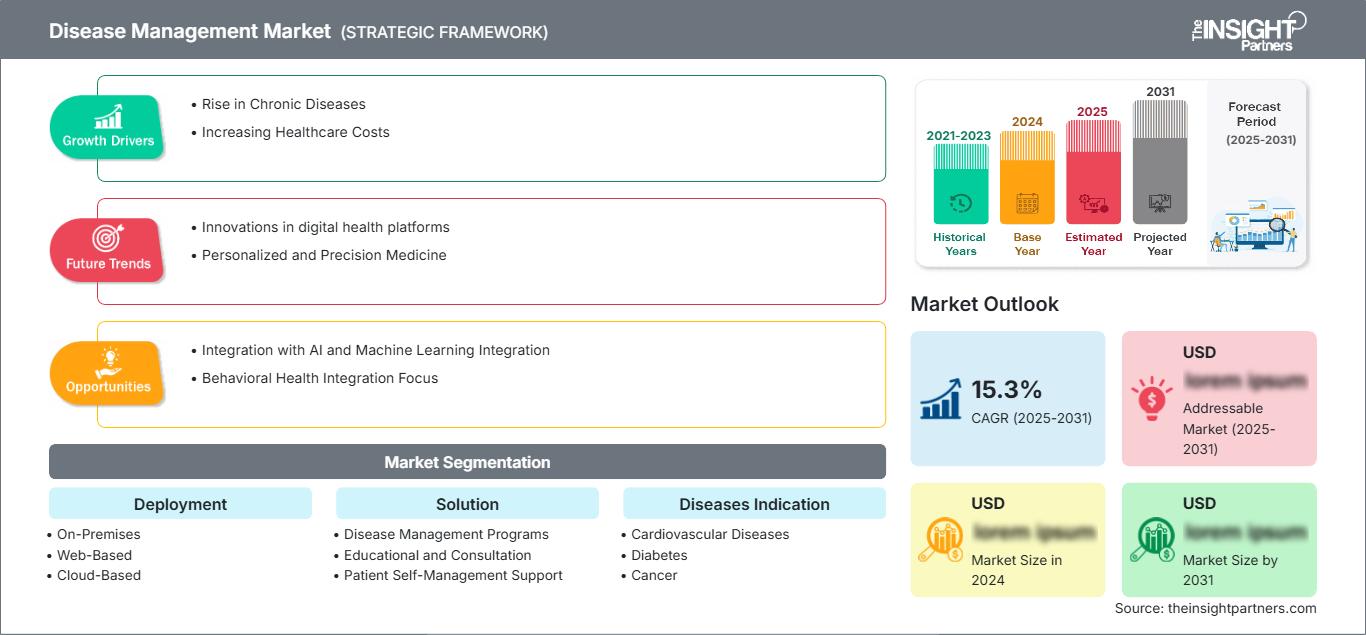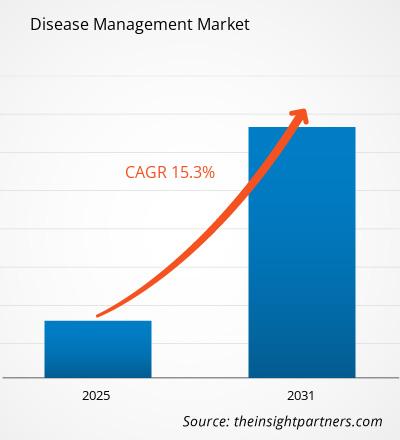Le marché de la gestion des maladies devrait atteindre 20,92 milliards de dollars américains d'ici 2031. Il devrait enregistrer un TCAC de 12,7 % entre 2025 et 2031.
Le rapport est segmenté par déploiement (sur site, via le Web, dans le nuage) ; solution (programmes de gestion des maladies, formation et consultation, soutien à l'autogestion des patients, technologies de l'information en santé, autres) ; indication (maladies cardiovasculaires, diabète, cancer, bronchopneumopathie chronique obstructive (BPCO), autres) ; utilisateurs finaux (payeurs, prestataires, autres). L'analyse mondiale est ensuite ventilée par région et par principaux pays. Le rapport présente la valeur en USD pour l'analyse et les segments ci-dessus.
Objectif du rapport
Le rapport sur le marché de la gestion des maladies, réalisé par The Insight Partners, vise à décrire le paysage actuel et la croissance future, les principaux facteurs de croissance, les défis et les opportunités. Il fournira des informations précieuses à divers acteurs du secteur, tels que :
- Fournisseurs de technologies/Fabricants : Pour comprendre l'évolution de la dynamique du marché et identifier les opportunités de croissance potentielles, afin de prendre des décisions stratégiques éclairées.
- Investisseurs : Pour réaliser une analyse approfondie des tendances concernant le taux de croissance du marché, les projections financières et les opportunités tout au long de la chaîne de valeur.
- Organismes de réglementation : Pour encadrer les politiques et les activités du marché afin de minimiser les abus, préserver la confiance des investisseurs et garantir l'intégrité et la stabilité du marché.
Segmentation du marché de la gestion des maladies et déploiement
- Sur site
- Basé sur le Web
- Basé sur le nuage
Solution
- Programmes de gestion des maladies
- Éducation et consultation
- Soutien à l'autogestion des patients
- Technologies de l'information en santé
Indications pathologiques
- Maladies cardiovasculaires
- Diabète
- Cancer
- Bronchopneumopathie chronique obstructive
Utilisateurs finaux
- Payeurs
- Fournisseurs
- Autres
Vous bénéficierez d’une personnalisation sur n’importe quel rapport - gratuitement - y compris des parties de ce rapport, ou une analyse au niveau du pays, un pack de données Excel, ainsi que de profiter d’offres exceptionnelles et de réductions pour les start-ups et les universités
Marché de la gestion des maladies: Perspectives stratégiques

- Obtenez les principales tendances clés du marché de ce rapport.Cet échantillon GRATUIT comprendra une analyse de données, allant des tendances du marché aux estimations et prévisions.
Facteurs de croissance du marché de la gestion des maladies
- Augmentation des maladies chroniques : L’un des principaux moteurs du marché de la gestion des maladies est la prévalence croissante des maladies chroniques dans le monde. Des affections telles que le diabète, l’hypertension, les maladies cardiovasculaires et les troubles respiratoires sont en hausse en raison de facteurs comme le vieillissement de la population, les modes de vie malsains et les facteurs environnementaux. Le nombre croissant de personnes atteintes de maladies chroniques a entraîné une demande accrue de solutions de gestion des maladies capables d’améliorer la prise en charge des patients, de réduire les hospitalisations et de gérer efficacement les problèmes de santé de longue durée.
- Augmentation des coûts des soins de santé : L’augmentation des coûts des soins de santé est une préoccupation majeure pour les gouvernements et les prestataires de soins de santé du monde entier. Les maladies chroniques, en particulier, représentent un fardeau financier important pour les systèmes de santé en raison des besoins de traitement à long terme, des hospitalisations fréquentes et des soins d’urgence. Les programmes de gestion des maladies qui mettent l’accent sur les soins préventifs, l’intervention précoce et la gestion à long terme des affections chroniques sont de plus en plus considérés comme une solution pour réduire les coûts des soins de santé. Ces programmes contribuent à minimiser les hospitalisations, à améliorer l'observance des traitements par les patients et à réduire les dépenses de santé globales.
Tendances futures du marché de la gestion des maladies
- Innovations dans les plateformes de santé numérique : Les plateformes de santé numérique, grâce à de nouvelles analyses, une surveillance en temps réel et des interfaces plus conviviales, devraient gagner en popularité. Elles favoriseront probablement une meilleure communication entre les patients et les professionnels de santé. Les modèles de gestion des maladies seront centrés sur le patient, prenant en compte ses préférences et ses besoins.
- Médecine personnalisée et de précision : Face à l'évolution constante de la médecine, la médecine personnalisée et de précision s'impose comme une tendance majeure dans la gestion des maladies. Grâce aux progrès de la génomique et de l'identification des biomarqueurs, les professionnels de santé peuvent désormais adapter les plans de traitement à chaque patient en fonction de son profil génétique, de son mode de vie et des caractéristiques spécifiques de sa maladie. Cette tendance devrait améliorer l'efficacité des programmes de gestion des maladies en ciblant les traitements les plus adaptés à chaque patient, en optimisant les résultats et en minimisant les effets secondaires.
Opportunités du marché de la gestion des maladies
- Intégration de l'IA et de l'apprentissage automatique : L'utilisation de l'intelligence artificielle et de l'apprentissage automatique présente l'avantage d'améliorer la stratification des risques, l'analyse prédictive et la personnalisation des plans de traitement. Elle permet d'identifier les populations à risque et d'adapter efficacement les interventions à leurs besoins.
- Intégration de la santé mentale : L'intégration des services de santé mentale dans la gestion des maladies chroniques constitue un modèle de soins complet qui favorise une approche à la fois physique et psychologique. L'intégration des services de santé mentale dans la gestion des maladies chroniques améliore l'état de santé général des patients atteints de maladies chroniques.
Marché de la gestion des maladies
Les analystes de The Insight Partners ont analysé en détail les tendances régionales et les facteurs influençant le marché de la gestion des maladies tout au long de la période prévisionnelle. Cette section aborde également les segments et la répartition géographique du marché de la gestion des troubles du rythme cardiaque en Amérique du Nord, en Europe, en Asie-Pacifique, au Moyen-Orient et en Afrique, ainsi qu'en Amérique du Sud et centrale.
Portée du rapport sur le marché de la gestion des maladies
| Attribut de rapport | Détails |
|---|---|
| Taille du marché en 2024 | US$ XX Billion |
| Taille du marché par 2031 | US$ 20.92 Billion |
| TCAC mondial (2025 - 2031) | 12.7% |
| Données historiques | 2021-2023 |
| Période de prévision | 2025-2031 |
| Segments couverts |
By Déploiement
|
| Régions et pays couverts | Amérique du Nord
|
| Leaders du marché et profils d'entreprises clés |
|
Densité des acteurs du marché de la gestion des maladies : comprendre son impact sur la dynamique commerciale
Le marché de la gestion des maladies est en pleine expansion, porté par une demande croissante des utilisateurs finaux, elle-même alimentée par l'évolution des préférences des consommateurs, les progrès technologiques et une meilleure connaissance des avantages des produits. Face à cette demande grandissante, les entreprises élargissent leur offre, innovent pour répondre aux besoins des consommateurs et tirent parti des tendances émergentes, ce qui stimule davantage la croissance du marché.

- Obtenez le Marché de la gestion des maladies Aperçu des principaux acteurs clés
Points clés de la vente
- Couverture exhaustive : Ce rapport analyse en détail les produits, services, types et utilisateurs finaux du marché de la gestion des maladies, offrant ainsi une vision globale.
- Analyse d'experts : Ce rapport repose sur une connaissance approfondie du secteur et des analystes.
- Informations actualisées : Grâce à sa couverture des informations et tendances les plus récentes, ce rapport garantit la pertinence des analyses pour les entreprises.
- Options de personnalisation : Ce rapport peut être personnalisé pour répondre aux besoins spécifiques des clients et s'adapter parfaitement à leurs stratégies commerciales.
Ce rapport d'étude de marché sur la gestion des maladies peut donc contribuer à décrypter et comprendre le contexte sectoriel et les perspectives de croissance. Malgré quelques points à améliorer, les avantages globaux de ce rapport tendent à surpasser ses inconvénients.
- Analyse historique (2 ans), année de base, prévision (7 ans) avec TCAC
- Analyse PEST et SWOT
- Taille du marché Valeur / Volume - Mondial, Régional, Pays
- Industrie et paysage concurrentiel
- Ensemble de données Excel
Rapports récents
Rapports connexes
Témoignages
Raison d'acheter
- Prise de décision éclairée
- Compréhension de la dynamique du marché
- Analyse concurrentielle
- Connaissances clients
- Prévisions de marché
- Atténuation des risques
- Planification stratégique
- Justification des investissements
- Identification des marchés émergents
- Amélioration des stratégies marketing
- Amélioration de l'efficacité opérationnelle
- Alignement sur les tendances réglementaires




















 Obtenez un échantillon gratuit pour - Marché de la gestion des maladies
Obtenez un échantillon gratuit pour - Marché de la gestion des maladies